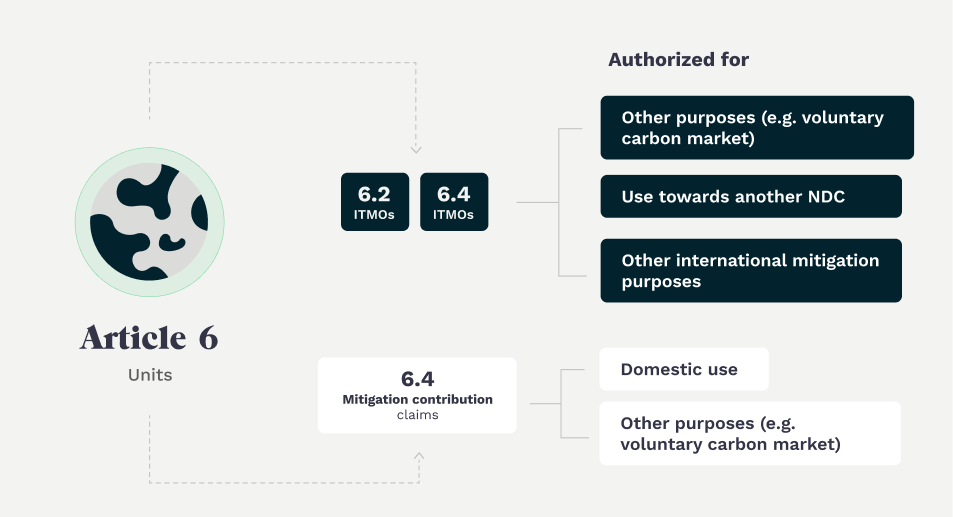Over the last few weeks, the voluntary carbon market (VCM) has seen a significant increase in policy, standards, and framework updates.
These developments include the new Science Based Targets Initiative (SBTi) Beyond Value Chain Mitigation (BVCM) guidance, the recently updated Oxford Principles for Net Zero-Aligned Carbon Offsetting by the University of Oxford, and the Nature Restoration Law. The latter emphasizes restoring natural ecosystems, and we expect it to accelerate the financing of nature-based projects (not necessarily through carbon credits).
These updates underscore the urgency of climate action and encourage companies to achieve Net Zero by aligning their emissions reduction targets with a comprehensive carbon reduction investment strategy. This includes investing in emission reduction beyond their own value chain, such as through voluntary carbon credits and projects, in addition to decarbonizing their operations.
As a reminder, the Paris Agreement calls for limiting global warming to 1.5°C, and to do so, emissions must be cut by 45% by 2030 and reach net-zero by 2050. Therefore, companies need to reduce the emissions produced within their value chains, but also engage in Beyond Value Chain Mitigation, which is the next step for them to reach net-zero carbon emissions and go beyond their near-term and long-term science-based targets. More information on this can be found in this article: https://climateseed.com/blog/sbti-net-zero
This article will provide a comprehensive view of these new guidelines, which aim to accelerate the financing of carbon reduction projects outside a company’s value chain.
SBTi Beyond Value Chain Mitigation guidelines
The SBTi was established in 2015 to help companies set emission reduction targets in line with climate sciences and Paris Agreement goals. The SBTi has recently released its new Beyond Value Chain Mitigation guidelines for 2024, meant to support the design and implementation of beyond value chain mitigation (BVCM). These reports highlight key points:
- Offsetting of at least 50% of scope 1, 2, and 3 emissions avoidance and removal. The SBTi advises companies to allocate a financial budget from their emissions for climate action beyond the scope of the company's science-based target (carbon offsetting), suggesting at least 50% of this budget should fund verified emissions reductions and removals equivalent to half of their unabated scope 1, 2, and 3 emissions.
- Adopting a forward-looking carbon offsetting strategy (five years or greater).
- Focusing on social and environmental impacts to scale up additional near-term and long-term mitigation.
The reports found a real business case for BVCM: SBTi engaged with over 200 companies, revealing that these companies can unlock an array of opportunities. This includes mitigating future risks and protecting and enhancing long-term value.
Specifically, BVCM offers a mechanism for greater resilience for companies reliant on natural capital. It also supports brand differentiation, talent acquisition and retention, technology transition opportunities, and adaptation to social expectations and market changes, among other benefits.
Although the SBTi does not plan to validate BVCM claims directly, the Voluntary Carbon Market Integrity (VCMI) initiative’s Claims Code of Practice introduces a framework for companies to claim the use of high-quality carbon credits credibly. These claims are categorized into three levels: Carbon Integrity Silver, Gold, and Platinum, based on the extent of emissions reductions and carbon credit investments. An exemplary achievement within this framework is Bain & Company's Carbon Integrity Platinum Claim.
Important update
The Science Based Targets Initiative (SBTi) made a significant announcement on April 9th regarding the use of carbon credits to address Scope 3 emissions, sparking a lively debate among stakeholders. Traditionally, frameworks such as the GHG Protocol and SBTi's guidelines emphasized a strict separation between emissions reduction efforts and the purchase of carbon credits. However, SBTi's recent statement introduces a more nuanced perspective, recognizing the potential of carbon credits when supported by appropriate policies and standards. This suggests a potential shift from their previously established net-zero standard in 2021. Although lacking in detailed specifics, this development could have significant implications for corporate sustainability strategies and environmental reporting, hinting at a possible shift in approach within the climate science and decarbonization discourse.
The Oxford Principles for Net Zero Aligned Carbon Offsetting
Oxford has also recently launched its updated Oxford Offsetting principles, emphasizing the need for offset credits to be credible and prioritizing long-term storage methods for carbon removal. These principles recognize the key role of biodiversity and removal.
The key takeaways from this revision are that organizations must focus on reducing their emissions before funding high-quality, durable removals. There is also a real need for companies to set additional targets for the restoration of ecosystems. Nature-based solutions are critical for addressing climate change.
The Nature Restoration Law
The European Parliament has recently adopted the Nature Restoration Law, to restore 20% of the EU's land and marine areas by 2030. This law acknowledges the urgent need to protect and restore biodiversity and calls for European companies to engage in BVCM - Beyond Value Chain Mitigation. Indeed, over 80% of European habitats are in poor condition, with peatlands, grasslands, and dunes being the worst affected. For context, in order to meet EU climate and biodiversity targets, the Commission suggested a nature restoration law on June 22, 2022, which would aid in the long-term repair of damaged natural areas along the EU's land and maritime areas. Significant economic gains would also come from this new rule, as each euro invested would provide benefits of at least 8 euros (and as much as 30 euros).
The EU Framework on Carbon Removal Certification
The European Union has also recently come up with a proposal for a regulation on an EU certification for carbon removals: the EU Framework on Carbon Removal certification, which was tentatively approved on February 20th. By investing in carbon removal projects in Europe, companies will be able to leverage this certification framework to demonstrate their environmental responsibility and credibility at the local level. This framework aims to boost innovative carbon removal technologies and sustainable carbon farming solutions while fighting greenwashing.
Corporate Sustainability Reporting Directive
CSRD covers disclosure on companies’ use of carbon credits and their quality.
Indeed, according to the ESRS E1 standard (one of the five environment-specific standards of the ESRS), developed by EFRAG and are to be applied in accordance with the CSRD, companies have to disclose the amount of GHG emission reductions and removals (in metric tonnes of CO2eq) from the purchase of carbon credits in Europe and outside.
How ClimateSeed can help
As the carbon market evolves with updates like the SBTi BVCM guidelines, Oxford Principles, the Nature Restoration Law, and the EU's Carbon Removal Certification, ClimateSeed offers precise solutions to align your carbon reduction strategy with these advancements. ClimateSeed provides consulting services and technological tools to measure GHG emissions, define reduction strategies, and contribute to premium carbon removal and avoidance projects, all tailored to help your company navigate these complex developments efficiently.
ClimateSeed supports over 200 organizations in their decarbonization journey. Contact us for more information.
Sources
https://climate.ec.europa.eu/eu-action/sustainable-carbon-cycles/carbon-removal-certification_en
https://sciencebasedtargets.org/beyond-value-chain-mitigation
https://www.smithschool.ox.ac.uk/sites/default/files/2022-01/Oxford-Offsetting-Principles-2020.pdf
Share this
You May Also Like
These Related Stories

COP28: Carbon Market Takeaways

Carbon offsetting vs. Climate contribution
.jpg?width=4928&height=3264&name=sun-shining-in-rain-drops-alt-sunset-in-nature-2022-02-02-03-49-48-utc%20(1).jpg)

